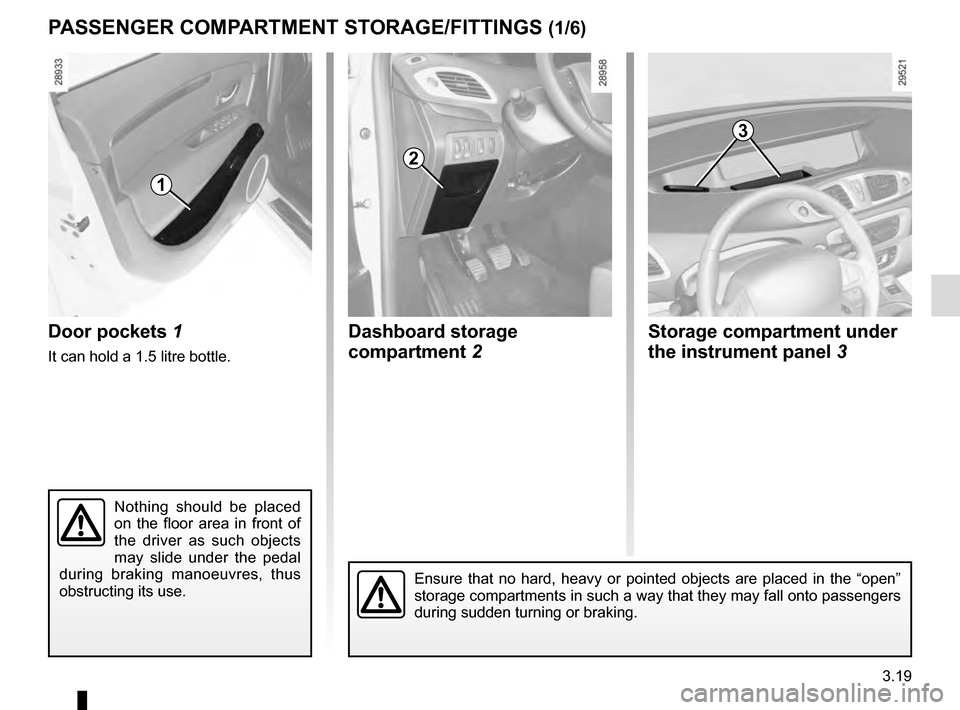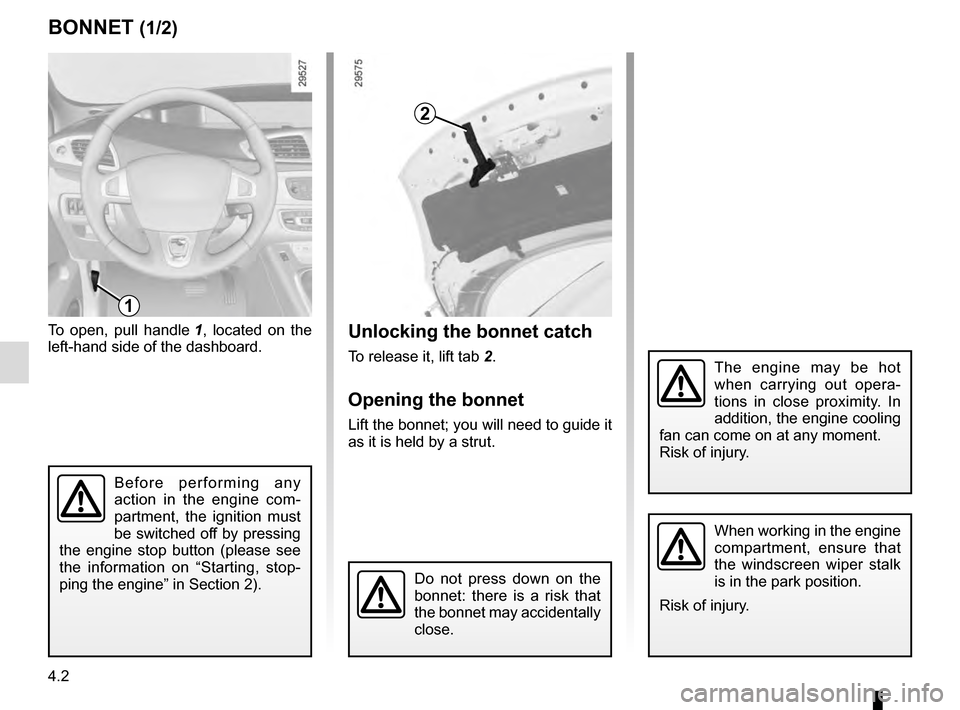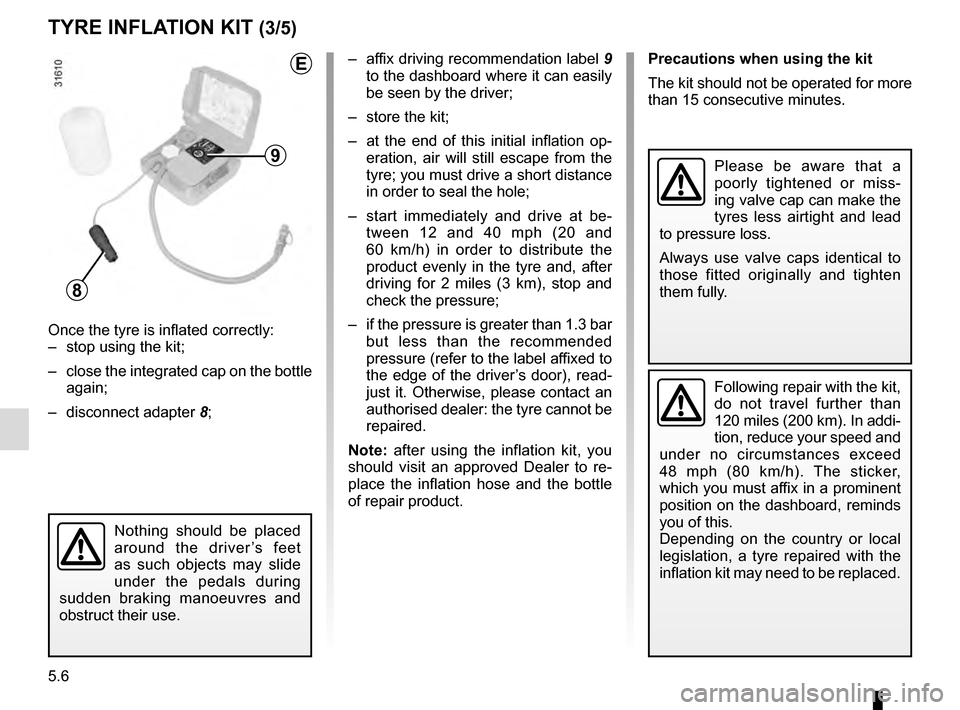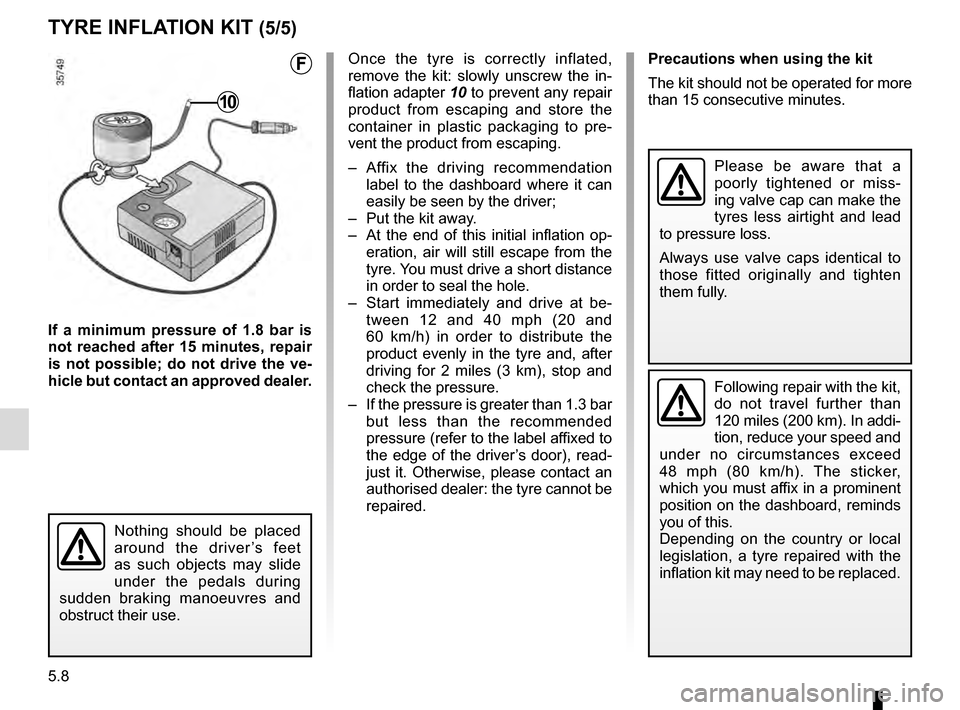2016 RENAULT SCENIC dashboard
[x] Cancel search: dashboardPage 159 of 270

3.19
Dashboard storage
compartment 2Door pockets 1
It can hold a 1.5 litre bottle.
PASSENGER COMPARTMENT STORAGE/FITTINGS (1/6)
1
Nothing should be placed
on the floor area in front of
the driver as such objects
may slide under the pedal
during braking manoeuvres, thus
obstructing its use.
Ensure that no hard, heavy or pointed objects are placed in the “open\
”
storage compartments in such a way that they may fall onto passengers
during sudden turning or braking.
2
Storage compartment under
the instrument panel 3
3
Page 184 of 270

4.2
BONNET (1/2)Unlocking the bonnet catch
To release it, lift tab 2.
Opening the bonnet
Lift the bonnet; you will need to guide it
as it is held by a strut.
To open, pull handle
1, located on the
left-hand side of the dashboard.
1
2
Do not press down on the
bonnet: there is a risk that
the bonnet may accidentally
close.
The engine may be hot
when carrying out opera-
tions in close proximity. In
addition, the engine cooling
fan can come on at any moment.
Risk of injury.
Before performing any
action in the engine com-
partment, the ignition must
be switched off by pressing
the engine stop button (please see
the information on “Starting, stop-
ping the engine” in Section 2).
When working in the engine
compartment, ensure that
the windscreen wiper stalk
is in the park position.
Risk of injury.
Page 200 of 270

4.18
You are strongly recom-
mended not to use high-
pressure or spray cleaning
equipment inside the pas-
senger compartment: use of such
equipment could impair the correct
functioning of the electrical or elec-
tronic components in the vehicle, or
have other detrimental effects.
INTERIOR TRIM MAINTENANCE (2/2)
You should not:
You are strongly advised not to po-
sition objects such as deodorants,
scents, etc. near air vents, as this could
damage your dashboard trim.
Removal/replacing removable
equipment originally fitted in
the vehicle
If you need to remove equipment in
order to clean the passenger com-
partment (for example, mats), always
ensure that they are correctly refitted
and are the right way around (the dri-
ver’s mat should be fitted on the driver’s
side, etc.) and fit them with the compo-
nents supplied with the equipment (for
example, the driver mat should always
be fixed using the pre-fitted mounting
components).
With the vehicle stationary, ensure that
nothing will impede driving (anything
obstructing the pedals, heel wedged by
the mat, etc.).
Page 205 of 270

5.5
TYRE INFLATION KIT (2/5)
Inflation kit E
Depending on the vehicle, in the event
of a puncture, use the kit located in
storage compartment C or underneath
luggage compartment carpet D.
Open the kit, remove caps 1 and 3 (the
cap must not be removed from the
bottle) then screw bottle 2 to its base 3.
Engine running, parking brake ap-
plied:
– unscrew the valve cap on the wheel concerned and screw inflation
adapter 6 onto the valve;
– connect adapter 8 to the accessories
socket on the dashboard of the vehi-
cle; – press switch
5 to inflate the tyre to
the recommended pressure (check
the label affixed to the edge of the
driver’s door);
– after a maximum of 5 minutes, stop inflating and read the pressure (on
pressure gauge 4);
Note: while the bottle is emptying
(approximately 30 seconds), pres-
sure gauge 4 will briefly indicate a
pressure of 6 bar, then the pressure
will drop.
– adjust the pressure: to increase it, continue inflating with the kit, to
reduce it, turn button 7 located on
the inflation adapter.
C
D
If a minimum pressure of 1.8 bar is
not reached after 15 minutes, repair
is not possible; do not drive the ve-
hicle but contact an approved dealer.1234
5
6
78
C
D
E
Before using this kit, park
the vehicle at a sufficient
distance from traffic, switch
on the hazard warning
lights, apply the handbrake, ask all
passengers to leave the vehicle and
keep them away from traffic.
If the vehicle is parked on
the hard shoulder, you must
warn other road users of
your vehicle’s presence
with a warning triangle or with other
devices as per the legislation apply-
ing to the country you are in.
Page 206 of 270

5.6
TYRE INFLATION KIT (3/5)
Precautions when using the kit
The kit should not be operated for more
than 15 consecutive minutes.
Nothing should be placed
around the driver’s feet
as such objects may slide
under the pedals during
sudden braking manoeuvres and
obstruct their use.
Please be aware that a
poorly tightened or miss-
ing valve cap can make the
tyres less airtight and lead
to pressure loss.
Always use valve caps identical to
those fitted originally and tighten
them fully.
Following repair with the kit,
do not travel further than
120 miles (200 km). In addi-
tion, reduce your speed and
under no circumstances exceed
48 mph (80 km/h). The sticker,
which you must affix in a prominent
position on the dashboard, reminds
you of this.
Depending on the country or local
legislation, a tyre repaired with the
inflation kit may need to be replaced.
9
8
Once the tyre is inflated correctly:
– stop using the kit;
– close the integrated cap on the bottle again;
– disconnect adapter 8;– affix driving recommendation label
9
to the dashboard where it can easily
be seen by the driver;
– store the kit;
– at the end of this initial inflation op- eration, air will still escape from the
tyre; you must drive a short distance
in order to seal the hole;
– start immediately and drive at be- tween 12 and 40 mph (20 and
60 km/h) in order to distribute the
product evenly in the tyre and, after
driving for 2 miles (3 km), stop and
check the pressure;
– if the pressure is greater than 1.3 bar but less than the recommended
pressure (refer to the label affixed to
the edge of the driver’s door), read-
just it. Otherwise, please contact an
authorised dealer: the tyre cannot be
repaired.
Note: after using the inflation kit, you
should visit an approved Dealer to re-
place the inflation hose and the bottle
of repair product.
E
Page 208 of 270

5.8
TYRE INFLATION KIT (5/5)
Precautions when using the kit
The kit should not be operated for more
than 15 consecutive minutes.
Nothing should be placed
around the driver’s feet
as such objects may slide
under the pedals during
sudden braking manoeuvres and
obstruct their use.
Please be aware that a
poorly tightened or miss-
ing valve cap can make the
tyres less airtight and lead
to pressure loss.
Always use valve caps identical to
those fitted originally and tighten
them fully.
Following repair with the kit,
do not travel further than
120 miles (200 km). In addi-
tion, reduce your speed and
under no circumstances exceed
48 mph (80 km/h). The sticker,
which you must affix in a prominent
position on the dashboard, reminds
you of this.
Depending on the country or local
legislation, a tyre repaired with the
inflation kit may need to be replaced.
10
If a minimum pressure of 1.8 bar is
not reached after 15 minutes, repair
is not possible; do not drive the ve-
hicle but contact an approved dealer. Once the tyre is correctly inflated,
remove the kit: slowly unscrew the in-
flation adapter
10 to prevent any repair
product from escaping and store the
container in plastic packaging to pre-
vent the product from escaping.
– Affix the driving recommendation label to the dashboard where it can
easily be seen by the driver;
– Put the kit away.
– At the end of this initial inflation op- eration, air will still escape from the
tyre. You must drive a short distance
in order to seal the hole.
– Start immediately and drive at be- tween 12 and 40 mph (20 and
60 km/h) in order to distribute the
product evenly in the tyre and, after
driving for 2 miles (3 km), stop and
check the pressure.
– If the pressure is greater than 1.3 bar but less than the recommended
pressure (refer to the label affixed to
the edge of the driver’s door), read-
just it. Otherwise, please contact an
authorised dealer: the tyre cannot be
repaired.
F
Page 263 of 270

7.1
ALPHABETICAL INDEX (1/5)
A
ABS ..............................................................1.56, \
2.24 → 2.28
accessories.............................................................\
........... 5.30
accessories socket ............................................................ 3.25
additional methods of restraint .....................1.23 → 1.26, 1.29
side protection ............................................................. 1.28
to the rear seat belts ........................................1.23 → 1.27
adjusting your driving position ........................................... 1.19
advice on antipollution ...........................................2.15 → 2.18
air bag...........................................................1.23 → 1.29, 1.56
activating the front passenger air bags ........................ 1.48
deactivating the front passenger air bags .................... 1.46
air conditioning ........................................................ 3.4 → 3.11
air vents ...................................................................... 3.2 – 3.3
anti-corrosion check ..............................................6.16 → 6.21
anti-corrosion protection .................................................... 4.15
anti-lock braking system: ABS ......................1.56, 2.24 → 2.28
antipollution advice .................................................................\
2.15, 2.18
armrest: front ..................................................................\
............ 3.21
rear ...................................................................\
........... 3.23
ashtray ................................................................\
............... 3.25
automatic gearbox (use) ........................................2.44 → 2.46
automatic gearbox selector lever...........................2.44 → 2.46
B
battery.................................................................\
.... 4.13 – 4.14 troubleshooting ................................................. 5.27 – 5.28
bonnet..................................................................\
....... 4.2 – 4.3
brake fluid ........................................................................\
.... 4.9
bulbs changing ..........................................................5.16 \
→ 5.22
C
catalytic converter.....................................................\
2.9 – 2.10 central door locking ........................................ 1.8, 1.11
→ 1.13
changing a bulb .....................................................5.16 → 5.22
changing a wheel.................................................... 5.11 – 5.12
changing gear ............................................... 2.11, 2.44 → 2.46
child restraint/seat .............................1.30 – 1.31, 1.33 → 1.45
child safety.........1.2, 1.6, 1.10, 1.30 – 1.31, 1.33 → 1.45, 3.12
child seats..........................................1.30 – 1.31, 1.3\
3 → 1.45
children .......................................................... 1.30 – 1.31, 1.31
children (safety) .......................................... 1.2, 1.6, 1.10, 3.12
cigar lighter ........................................................................\
3.25
cleaning: inside the vehicle .............................................. 4.17 – 4.18
clock ..................................................................\
................ 1.72
closing the doors .....................................................1.9 → 1.12
control instruments ............................1.54 → 1.58, 1.61 – 1.62
controls ...............................................................\
...1.50 → 1.53
courtesy light ...................................... 3.15 – 3.16, 5.23 – 5.24
courtesy mirrors ................................................................. 3.17
cruise control ................................................1.54, 2.31 → 2.37
cruise control-speed limiter....................................2.31 → 2.37
customised vehicle settings .............................................. 1.71
customising the vehicle settings ....................................... 1.71
D
dashboard..............................................................1\
.50 → 1.53
deadlocking the doors ......................................................... 1.8
dimensions ................................................................. 6.5 – 6.6
dipstick................................................................\
................. 4.4
display ................................................................\
...1.54 → 1.60
doors................................................................ 1.9 – 1.10, 1.13
doors/tailgate .........................................................\
.............. 1.8
driver’s position .....................................................1.50 → 1.58
driving ........ 2.2 → 2.5, 2.9 → 2.17, 2.20 → 2.28, 2.31 → 2.41,
2.44 → 2.46
driving position settings ...............................................................\
......... 1.19